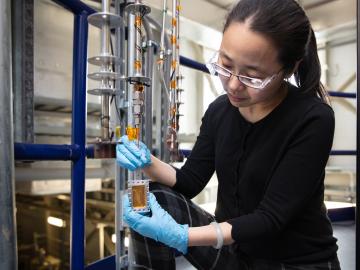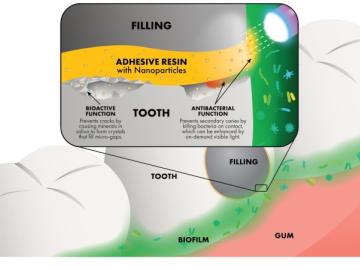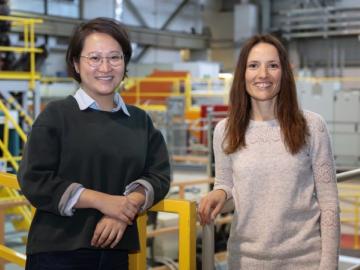
Filter News
Area of Research
- (-) Materials (61)
- (-) Neutron Science (119)
- Advanced Manufacturing (3)
- Biological Systems (1)
- Biology and Environment (105)
- Biology and Soft Matter (1)
- Computational Biology (2)
- Computational Engineering (2)
- Computer Science (4)
- Energy Science (64)
- Fusion and Fission (9)
- Fusion Energy (7)
- Isotopes (7)
- Materials for Computing (9)
- Mathematics (1)
- National Security (13)
- Nuclear Science and Technology (16)
- Nuclear Systems Modeling, Simulation and Validation (1)
- Quantum information Science (8)
- Supercomputing (68)
News Type
News Topics
- (-) Advanced Reactors (3)
- (-) Biomedical (20)
- (-) Environment (19)
- (-) Neutron Science (122)
- (-) Quantum Science (14)
- 3-D Printing/Advanced Manufacturing (27)
- Artificial Intelligence (11)
- Big Data (3)
- Bioenergy (16)
- Biology (11)
- Biotechnology (1)
- Buildings (4)
- Chemical Sciences (33)
- Clean Water (4)
- Composites (9)
- Computer Science (24)
- Coronavirus (13)
- Critical Materials (13)
- Cybersecurity (5)
- Energy Storage (36)
- Exascale Computing (2)
- Fossil Energy (1)
- Frontier (3)
- Fusion (7)
- Grid (4)
- High-Performance Computing (5)
- Hydropower (1)
- Isotopes (13)
- ITER (1)
- Machine Learning (6)
- Materials (76)
- Materials Science (80)
- Mathematics (1)
- Microscopy (24)
- Molten Salt (3)
- Nanotechnology (40)
- National Security (4)
- Nuclear Energy (16)
- Partnerships (11)
- Physics (28)
- Polymers (17)
- Quantum Computing (4)
- Security (3)
- Space Exploration (5)
- Summit (6)
- Transportation (18)
Media Contacts

An ORNL-led team's observation of certain crystalline ice phases challenges accepted theories about super-cooled water and non-crystalline ice. Their findings, reported in the journal Nature, will also lead to better understanding of ice and its various phases found on other planets, moons and elsewhere in space.

Tempering, the heating process that gives chocolate its appealing sheen and creamy texture, is a crucial part of crafting quality chocolate. But, at the molecular level, it gets a little tricky, and when done incorrectly, can render entire batches of chocolate gritty and unappetizing.

OAK RIDGE, Tenn., May 14, 2019—Advanced Research Systems, Inc., has licensed a technology designed to automatically refill liquid helium used in laboratory equipment for low-temperature scientific experiments, which will reduce downtime, recover more helium and increase overall efficiency.

OAK RIDGE, Tenn., May 7, 2019—Energy Secretary Rick Perry, Congressman Chuck Fleischmann and lab officials today broke ground on a multipurpose research facility that will provide state-of-the-art laboratory space

Researchers at the Department of Energy’s Oak Ridge National Laboratory, Pacific Northwest National Laboratory and Washington State University teamed up to investigate the complex dynamics of low-water liquids that challenge nuclear waste processing at federal cleanup sites.

To help address the issue of dental restoration, Oak Ridge National Laboratory researchers are using neutron scattering to study how nanoparticles with antibacterial properties can be added to adhesive resins, which are used by dentists to strengthen the bond between a tooth and its polymer composite filling.

OAK RIDGE, Tenn., March 20, 2019—Direct observations of the structure and catalytic mechanism of a prototypical kinase enzyme—protein kinase A or PKA—will provide researchers and drug developers with significantly enhanced abilities to understand and treat fatal diseases and neurological disorders such as cancer, diabetes, and cystic fibrosis.


OAK RIDGE, Tenn., March 1, 2019—ReactWell, LLC, has licensed a novel waste-to-fuel technology from the Department of Energy’s Oak Ridge National Laboratory to improve energy conversion methods for cleaner, more efficient oil and gas, chemical and

Yue Yuan, a second-year PhD student at NC State University’s Wilson College of Textiles, is working to create textiles that filter carbon dioxide (CO2) by using the latest scientific techniques in synthesis and imaging. Known as biocatalytic textiles, these materials could serve as sustainable scrubbers for CO2 capture by using enzymes trapped in bio-based polymers to catalyze the hydration of CO2.


